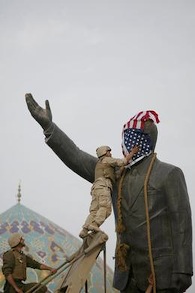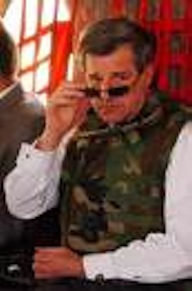Review: The Lost Year in Iraq
10/18/06 01:16 AM


By ED BARK
Just how did things come to this? It's the overriding question of our times as mid-term elections near while America remains stuck in the land without weapons of mass destruction.
PBS' The Lost Year in Iraq, presented under the prestigious Frontline banner, spells out some cold, hard truths Tuesday night (9 p.m. locally on KERA/Channel 13). Beginning with the toppling of Saddam Hussein's statue and ending with U.S. Ambassador L. Paul Bremer III's evacuation, the one-hour program puts a pivotal freshman year in perspective. It's a story of missed opportunities, poor preparations and infighting that only led to more fighting. In hindsight . . . well, it always seems to go that way, doesn't it?
Baghdad fell in just three weeks, on April 9, 2003. At first it looked like a cakewalk, with U.S. troops as liberators who'd mostly be home by Christmas of that year.
"People were just in pure exhilaration," remembers Lt. Col. R. Alan King. "At that point you think, 'This might just work, and we have an opportunity.' A guy was carrying a huge couch on his back, and he turns and says, 'Yay, America'."
Looters initially were allowed to run wild. But matters quickly escalated into car jackings and kidnappings, "a DNA chain to the insurgency," says former ambassador Barbara Bodine. "That was the spark."
Defense Secretary Donald Rumsfeld, who declined to be interviewed along with all other current members of the Bush administration, characterized the early violence as exuberant behavior by the previously oppressed. It's still hard to believe that he actually said, "Freedom's untidy, and free people are free to make mistakes and to commit crimes and do bad things; they're also free to live their lives and do wonderful things."
Bremer, then managing director of Henry Kissinger and Associates, soon rode in as an anointed Lancelot charged with making things right. Others contend that he did two things very wrong -- alienating the Ba'athists by purging them from all government offices and infuriating the Iraqi military by dissolving it.
Several U.S. military officers, in new interviews, say they were counting heavily on the Iraqi army to help them in the reconstruction effort.
"It shocked many of us," recalls Col. Paul Hughes. "Up to that time I had these guys pretty much doing anything I wanted them to do."
Adds Col. Thomas X. Hammes: "Now you have a couple hundred thousand people who are armed, because they took their weapons home with them. They know how to use the weapons, have no future and have a reason to be angry at you."
Bremer, who also spoke to Frontline, says he doesn't remember if any of his sweeping early edicts faced strong opposition from within his own ranks. Jay Garner, a retired general who preceded Bremer in Iraq as Rumsfeld's handpicked leader of the reconstruction effort, says the "de-Ba'athification" policy in fact was viewed as potentially very dangerous. In his and others' view, it would drive 30,000 to 50,000 perceived Saddam loyalists "underground by nightfall."
How many of them, along with disgruntled Iraqi soldiers, now are involved in the ongoing insurrection? Nobody really knows. Nobody really wants to know.
The Lost Year obviously isn't the last word on Iraq. It is, however, a dispiriting dissection of little gained and much lost in a period capped by the Abu Ghraib prison scandal. Those weren't pretty pictures, and neither is this. Bremer, now long gone, says he tried his level best.
"I think on the whole, the American people can say we did a noble thing," he tells Frontline. "We put the Iraqis on the right path ... to a better political future. And they now have got, certainly, the right plans to rebuild their economy. All that remains now is to effect a security strategy that defeats the Sunni insurgency."
Oh yes, there's still that.
|
